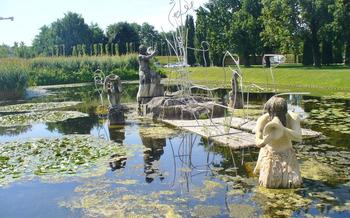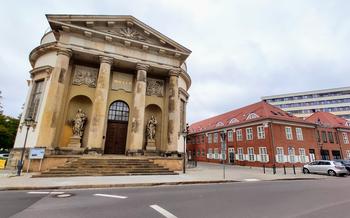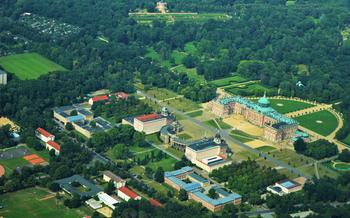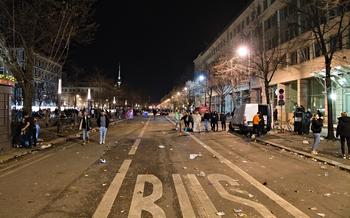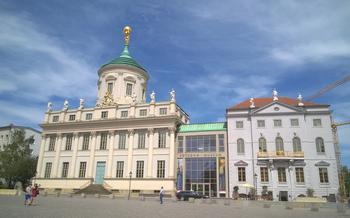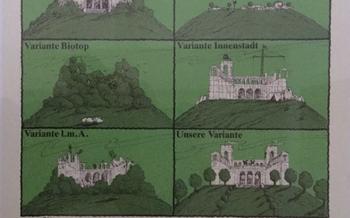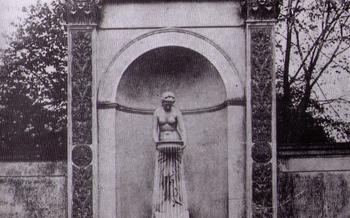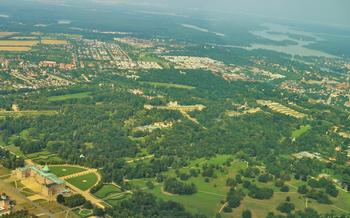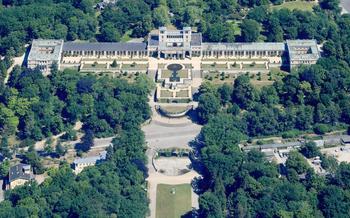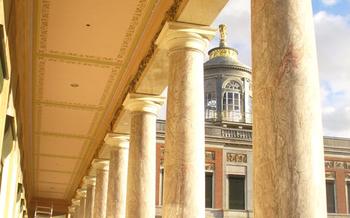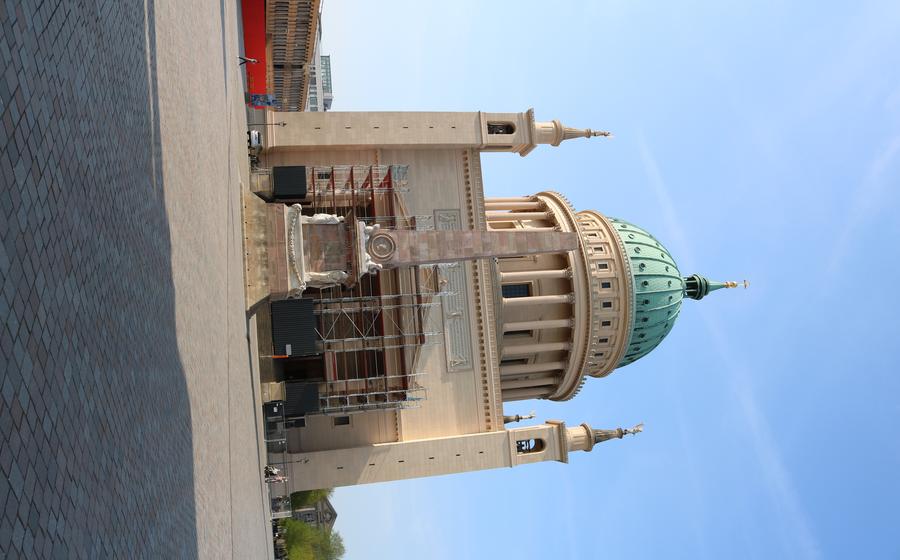
The Old Market Square (Alter Markt)
- The Old Market Square (Alter Markt), Potsdam
- St. Nicholas' Church
- Potsdam City Hall
- The Neptune Fountain
- Alte Fahrt (Old Course)
- Brandenburg Gate
- Havel River
- Sanssouci Palace
- Potsdam Film Museum
- The Orangery Palace
- Charlottenhof Palace
- Babelsberg Park
- Babelsberg Palace
- Insider Tip
The Old Market Square (Alter Markt), Potsdam
The Old Market Square, or Alter Markt, in Potsdam is a vibrant historical and cultural hub, attracting visitors with its charm and rich heritage. Founded in the 17th century as the city's market center, the square has evolved into a captivating blend of architectural landmarks, cultural events, and lively atmosphere.
Historical significance
The Old Market Square holds immense historical significance, having witnessed pivotal moments in Potsdam's history. Originally a bustling marketplace, the square served as a gathering place for merchants, farmers, and locals to trade and socialize. Over time, it became a focal point for various events, including public executions, festivals, and celebrations. During World War II, the square suffered extensive damage but was meticulously reconstructed after the war, preserving its historical essence.
Architectural highlights
The Old Market Square boasts an array of architectural masterpieces, each contributing to its distinct character. St. Nicholas' Church, with its imposing Baroque facade and majestic bell tower, dominates the square. The imposing Potsdam City Hall, with its ornate exterior and symbolic tower, reflects the city's administrative power. The Neptune Fountain, with its captivating sculptural details, adds a touch of playfulness and grandeur.
Cultural events
The Old Market Square is a hub of cultural activity, hosting various events throughout the year that showcase Potsdam's vibrant arts scene. From traditional German markets and festivals to concerts, art exhibitions, and theater performances, there's always something to engage and entertain visitors.
Must-see attractions
In addition to the architectural and cultural highlights, the Old Market Square offers several must-see attractions. The Brandenburg Gate, a replica of the iconic Berlin landmark, serves as a reminder of Potsdam's Prussian heritage. The Havel River, with its picturesque bridges and boat tours, provides a serene escape from the city's hustle and bustle. Sanssouci Park, with its stunning gardens and elegant palaces, is a UNESCO World Heritage Site and a must-visit for history and nature enthusiasts alike.
St. Nicholas' Church
St. Nicholas' Church, proudly standing in the heart of the Old Market Square, is a magnificent edifice that commands attention with its striking architectural style and profound historical significance. Constructed in the late 19th century, this neo-Gothic masterpiece is a testament to the architectural prowess of the era. Its intricate facade, adorned with delicate carvings and towering spires, reflects the revivalist spirit of the time, while its imposing presence adds grandeur to the square.
St. Nicholas' Church holds immense historical importance as a symbol of Potsdam's resilience and faith. During the tragic events of World War II, the church suffered severe damage fromAllied bombing, leaving it in ruins. However, its indomitable spirit and the unwavering dedication of the community led to its meticulous reconstruction, which was completed in the 1980s. Today, the church stands as a testament to the triumph of hope over adversity and is a source of pride for the people of Potsdam.
Step inside the church, and you will be captivated by its awe-inspiring interiors. The soaring vaulted ceilings, elegant stained glass windows, and intricate frescoes create an atmosphere of tranquility and reverence. Take a moment to admire the exquisite altar, adorned with intricate carvings and sculptures, which serves as a focal point for worship and contemplation.
Guided tours of St. Nicholas' Church are available, providing visitors with a deeper insight into its rich history, architectural significance, and enduring legacy. Whether you are a history buff, an architecture enthusiast, or simply someone seeking spiritual inspiration, a visit to St. Nicholas' Church is an enriching experience that should not be missed.
Potsdam City Hall
The Potsdam City Hall, located in the heart of the Alter Markt, is an impressive example of Neo-Renaissance architecture. Constructed between 1750 and 1753, it served as the seat of the city's administration for centuries. The building's striking facade boasts intricate carvings, elegant columns, and a towering clock tower, making it a focal point of the square.
Throughout its history, the Potsdam City Hall has witnessed numerous significant events. In 1806, it served as the headquarters of the Prussian army during the Battle of Jena-Auerstedt, and in 1918, it was the site of the proclamation of the German Republic. Today, the building continues to serve as a symbol of Potsdam's rich history and civic pride.
Currently, the Potsdam City Hall is open to the public, offering guided tours that provide insights into its architectural features, historical significance, and current use. Visitors can explore the grand ceremonial halls, admire the opulent decorations, and learn about the building's role in shaping the city's destiny.
The Neptune Fountain
In the heart of Potsdam's Old Market Square, the majestic Neptune Fountain stands as a testament to the city's rich history and cultural heritage. This awe-inspiring fountain, commissioned by the Prussian King Frederick William I in 1705, is a Baroque masterpiece that captures the essence of classical mythology and artistic grandeur.
The fountain's centerpiece is a colossal figure of the Roman sea god Neptune, valiantly wielding his mighty trident, as water gracefully cascades from his outstretched hand into the surrounding basin. The dynamic sculpture, created by the renowned sculptor Johann Georg Glume, exudes power and authority, symbolizing the Prussian monarchy's maritime ambitions and naval prowess.
Surrounding Neptune are four tritons, mythical sea creatures depicted as half-man, half-fish, each holding a conch shell and contributing to the fountain's captivating water display. These intricate figures, sculpted by the talented Friedrich Wilhelm Diterichs, add a touch of whimsy and enchantment to the overall composition.
The Neptune Fountain has witnessed countless historical events over the centuries, serving as a backdrop for royal celebrations, military parades, and grand ceremonies. It has undergone several renovations and restorations, most notably after the devastating bombings of World War II, which left the fountain severely damaged. Through meticulous restoration efforts, the fountain was brought back to its former glory, preserving its artistic and historical significance for generations to come.
Alte Fahrt (Old Course)
The Alte Fahrt, or Old Course, is a picturesque stretch of the Havel River that winds its way through the heart of Potsdam. This historic waterway, once a vital trade route, offers visitors a tranquil escape from the bustling city center and a chance to immerse themselves in the natural beauty of the region.
Scenic Views: The Alte Fahrt is renowned for its stunning vistas. As you glide along the river, you'll be treated to panoramic views of lush forests, rolling hills, and charming riverside villages. The tranquil waters reflect the vibrant colors of the surrounding landscape, creating a picture-perfect scene.
Historical Significance: The Alte Fahrt holds immense historical significance. In the 17th century, it served as a vital trade route connecting Potsdam to the surrounding regions. Boats laden with goods and produce would navigate the river, contributing to the economic growth and prosperity of the city. The Old Course also played a crucial role in the development of Potsdam as a royal residence. Prussian kings and their entourage would often use the river for pleasure cruises and excursions.
Boat Tours: Today, visitors can experience the beauty of the Alte Fahrt firsthand by taking a leisurely boat tour. Several companies offer guided tours that provide insights into the history and significance of the river. You can choose from a variety of boat options, ranging from small, intimate vessels to larger sightseeing cruises.
Water Sports: For those seeking a more active experience, the Alte Fahrt offers ample opportunities for water sports. Kayaking, canoeing, and stand-up paddleboarding are popular activities that allow you to explore the river at your own pace. Several rental shops along the riverbank provide equipment and guidance for beginners.
Brandenburg Gate
Architectural Design:
The Brandenburg Gate in Potsdam stands as a majestic symbol of Prussian architectural prowess. Constructed between 1770 and 1771, this triumphal arch boasts an impressive Corinthian-style design, featuring six imposing Doric columns on each side. The gate's sandstone facade is adorned with intricate sculptures and reliefs depicting scenes from Greek mythology, adding a touch of classical grandeur to the structure.
Historical Significance:
The Brandenburg Gate holds a significant place in the history of Potsdam. Erected during the reign of King Frederick II, also known as Frederick the Great, the gate served as a ceremonial entrance to the city. It marked the western end of the road connecting Berlin and Potsdam and was intended to symbolize Prussia's military might and territorial expansion.
Current Use:
Today, the Brandenburg Gate stands as a beloved landmark and a popular tourist destination in Potsdam. It has undergone several renovations and restorations over the years, preserving its original splendor for future generations. While the gate no longer serves as a city gate, it remains an iconic symbol of Potsdam's rich past and continues to draw visitors from around the world.
Guided Tours:
For a deeper understanding of the Brandenburg Gate's history and significance, visitors can participate in guided tours. These tours provide insights into the gate's architectural features, historical context, and its role in shaping Potsdam's identity. Guided tours are available in various languages, making the Brandenburg Gate accessible to visitors from different cultural backgrounds.
Havel River
The Havel River, a serene waterway flowing through Potsdam, adds to the city's enchanting allure. Its picturesque scenery, lined with lush greenery and historical bridges, offers a tranquil escape from the urban hustle. Embark on a leisurely river cruise, gliding past magnificent palaces and gardens, and soak in the beauty of Potsdam's riverside treasures.
For the adventurous, the Havel beckons with a variety of water sports. Whether you prefer kayaking, stand-up paddling, or sailing, the river provides an exhilarating playground. Dive into its refreshing waters and relish the thrill of navigating its gentle currents.
After an active day on the river, indulge in a delightful culinary experience at one of the many riverside restaurants. Savor regional delicacies while enjoying panoramic views of the Havel and its surroundings. As the sun dips below the horizon, the riverfront transforms into a magical setting, casting a golden glow upon the tranquil waters and the majestic buildings that line its banks.
Sanssouci Palace
Architectural Style and Historical Importance
Sanssouci Palace is a stunning example of Rococo architecture, characterized by its elaborate ornamentation, graceful curves, and pastel colors. Designed by the renowned architect Georg Wenzeslaus von Knobelsdorff, the palace was built between 1745 and 1747 as a summer retreat for Frederick the Great, King of Prussia.
The palace's exterior is adorned with intricate carvings, sculptures, and gilding, reflecting the opulence and grandeur of the Prussian court. The interior is equally impressive, featuring lavishly decorated rooms, each with its own unique theme and purpose. The palace's many highlights include the Marble Hall, with its stunning collection of antique sculptures, and the Concert Room, where Frederick the Great himself performed musical concerts.
Notable Landmarks and Guided Tours
Sanssouci Palace is surrounded by a sprawling park of the same name, which is a UNESCO World Heritage Site. The park is home to numerous other notable landmarks, including the Orangery Palace, the Charlottenhof Palace, and the New Palace. Visitors can explore the park's many gardens, fountains, and sculptures, or take a guided tour of the palace and its grounds.
Guided tours of Sanssouci Palace are available in several languages and provide visitors with an in-depth look at the palace's history, architecture, and interior design. Visitors can also choose to take a guided tour of the park, which highlights its many attractions and offers insights into its significance in Prussian history.
Potsdam Film Museum
Nestled amidst the cultural heart of Potsdam, the Potsdam Film Museum stands as a testament to the city's rich cinematic heritage. Housed within a beautifully restored Art Nouveau building, the museum offers a captivating journey through the history of German film, from its humble beginnings to its status as a global industry leader.
Step inside and be transported to a world of silver screens and celluloid dreams. Interactive exhibits take you behind the scenes of iconic productions, showcasing scripts, costumes, and props that bring the magic of filmmaking to life. Learn about the pioneering filmmakers who shaped the industry, from Fritz Lang to Marlene Dietrich, and discover how German cinema influenced and was influenced by global trends.
The museum's collection boasts an impressive array of historical film artifacts, including rare cameras, projectors, and editing equipment. Experience the evolution of filmmaking technology firsthand and gain insights into the challenges and triumphs that shaped the art form.
In addition to its permanent exhibits, the Potsdam Film Museum hosts regular film screenings, lectures, and workshops. Immerse yourself in the latest cinematic releases or delve into the classics, accompanied by insightful commentary from film experts.
Guided tours are available to provide a deeper understanding of the museum's collection and the history of German cinema. Knowledgeable guides share anecdotes and insider knowledge, bringing the exhibits to life and ensuring a truly immersive experience.
Whether you're a film buff, a history enthusiast, or simply seeking a unique cultural experience, the Potsdam Film Museum is a must-visit destination. Prepare to be captivated by the glamour, artistry, and innovation that have made German cinema a global force.
The Orangery Palace
The Orangery Palace, with its striking architectural design, is a magnificent sight to behold in Potsdam. Built in the late 18th century by King Frederick William II, it initially served the practical purpose of housing exotic citrus plants, hence its name. However, its significance extends beyond horticulture.
Over the years, the Orangery Palace has played a multifaceted role, hosting grand balls and festivities, serving as a guest house for distinguished visitors, and even functioning as a military hospital during the Napoleonic Wars. Today, it stands as a testament to the rich history of Potsdam and is open to the public for guided tours.
The palace's architectural style is a harmonious blend of Baroque and Classical elements. Its exterior facade is adorned with intricate carvings and sculptures, while the interior boasts opulent rooms with stunning frescoes, parquet floors, and crystal chandeliers. The Orangery Hall, the palace's central feature, is a grand and elegant space that has witnessed countless social gatherings and events throughout history.
Currently, the Orangery Palace is a vibrant cultural venue, hosting art exhibitions, concerts, and other cultural events. Visitors can explore the palace's history, admire its architectural beauty, and immerse themselves in the artistic and cultural offerings that bring this magnificent building to life.
Charlottenhof Palace
Charlottenhof Palace, nestled within the tranquil embrace of Sanssouci Park, stands as a testament to the architectural brilliance of the Prussian era. This enchanting palace, designed by the renowned architect Karl Friedrich Schinkel, embodies the quintessence of Neoclassical elegance, seamlessly blending elements of antiquity with the romanticism of the 19th century.
Charlottenhof Palace, commissioned by King Frederick William III in honor of his wife Queen Charlotte, exudes an aura of serenity and simplicity. Its exterior facade, adorned with graceful Ionic columns and delicate pediments, reflects the harmonious balance and proportion characteristic of Neoclassical architecture. The palace's interiors, meticulously crafted with intricate stuccowork, vibrant frescoes, and opulent furnishings, transport visitors to a bygone era of royalty and grandeur.
One of the highlights of Charlottenhof Palace is the Pompeian Room, an exquisite chamber inspired by the ancient city of Pompeii. This lavishly decorated room, adorned with vibrant frescoes depicting scenes from Roman mythology, offers a glimpse into the fascination with classical antiquity that pervaded the artistic sensibilities of the time.
Charlottenhof Palace is not merely a historical monument but also a vibrant cultural center. Throughout the year, the palace hosts a variety of events, including concerts, exhibitions, and theatrical performances, inviting visitors to immerse themselves in the rich cultural tapestry of Potsdam.
Guided tours of Charlottenhof Palace are available, providing visitors with an in-depth exploration of its history, architecture, and artistic treasures. These tours offer a unique opportunity to discover the secrets and stories that lie within the walls of this magnificent palace.
Babelsberg Park
Babelsberg Park, with its picturesque landscapes and serene atmosphere, offers a delightful retreat from the bustling city. This idyllic park, situated on the banks of the Havel River, boasts a rich historical legacy and serves as an oasis of tranquility for nature enthusiasts and history buffs alike.
Babelsberg Park was meticulously designed in the 19th century by renowned landscape architect Prince Hermann von Pückler-Muskau. His vision for the park was to create a harmonious blend of natural beauty and architectural elements, resulting in a masterpiece of garden design. Visitors can wander through the park's winding paths, admiring the vibrant flowerbeds, ancient trees, and serene ponds that grace its landscape.
Beyond its natural splendor, Babelsberg Park holds significant historical importance. Once the private domain of the Prussian royal family, the park was a favored retreat for royalty and nobility. Several elegant palaces and villas were constructed within its grounds, each reflecting the architectural styles of their respective eras. These architectural gems, including the Babelsberg Palace, the Flatow Tower, and the Orangery Palace, offer a glimpse into the lavish lifestyle of the Prussian aristocracy.
In addition to its historical significance, Babelsberg Park has gained international recognition as a center of film production. The legendary Babelsberg Film Studios, established in 1912, is located within the park's boundaries. This renowned studio has produced countless classic films over the decades, contributing to the park's reputation as a hub of creativity and cinematic excellence. Visitors can take guided tours of the film studios, gaining insights into the fascinating world of filmmaking and exploring the sets where iconic movies were brought to life.
Babelsberg Palace
Babelsberg Palace, with its striking red brick facade, is another architectural gem gracing the grounds of Babelsberg Park. Constructed between 1833 and 1849, this palace was commissioned by Prince William, later Emperor William I, as a summer residence.
Babelsberg Palace is renowned for its blend of Gothic and Tudor Revival styles, which showcase a charming asymmetry and intricate ornamentation. Its picturesque towers, gables, and bay windows create a captivating visual harmony that transports visitors to a bygone era.
Inside the palace, visitors can admire the opulent interiors, which reflect the grandeur and sophistication of the Prussian court. The state rooms, reception halls, and private chambers are adorned with exquisite furniture, tapestries, paintings, and decorative objects that offer a glimpse into the lavish lifestyle of the Prussian royalty.
Today, Babelsberg Palace serves as a museum, where visitors can explore its rich history and artistic heritage. Guided tours are available, allowing visitors to delve deeper into the palace's intriguing stories and gain insights into the lives of its former occupants.
Insider Tip
To make the most of your visit to Potsdam, consider these insider tips:
-
Best time to visit: Spring (April-May) and autumn (September-October) offer pleasant weather for exploring the city's outdoor attractions. During the summer months (June-August), Potsdam can be crowded with tourists, so it's best to visit during the shoulder seasons if you prefer a quieter experience.
-
Local culinary specialties: Be sure to try some of Potsdam's local delicacies, such as the "Potsdamer Scholle" (fried flounder), "Kartoffelpuffer" (potato pancakes), and "Mohnkuchen" (poppy seed cake).
-
Hidden gems off the beaten path: For a unique experience, venture beyond the main tourist attractions and explore some of Potsdam's hidden gems. Visit the Volkspark Potsdam, a beautiful park with stunning views of the city, or take a walk along the Glienicke Bridge, which connects Potsdam to Berlin and offers breathtaking views of the Havel River.
-
Practical tips for planning a trip: To avoid long lines, purchase tickets for attractions in advance, especially during the peak tourist season. Potsdam is a walkable city, but you can also rent a bike or take advantage of the public transportation system to get around.
